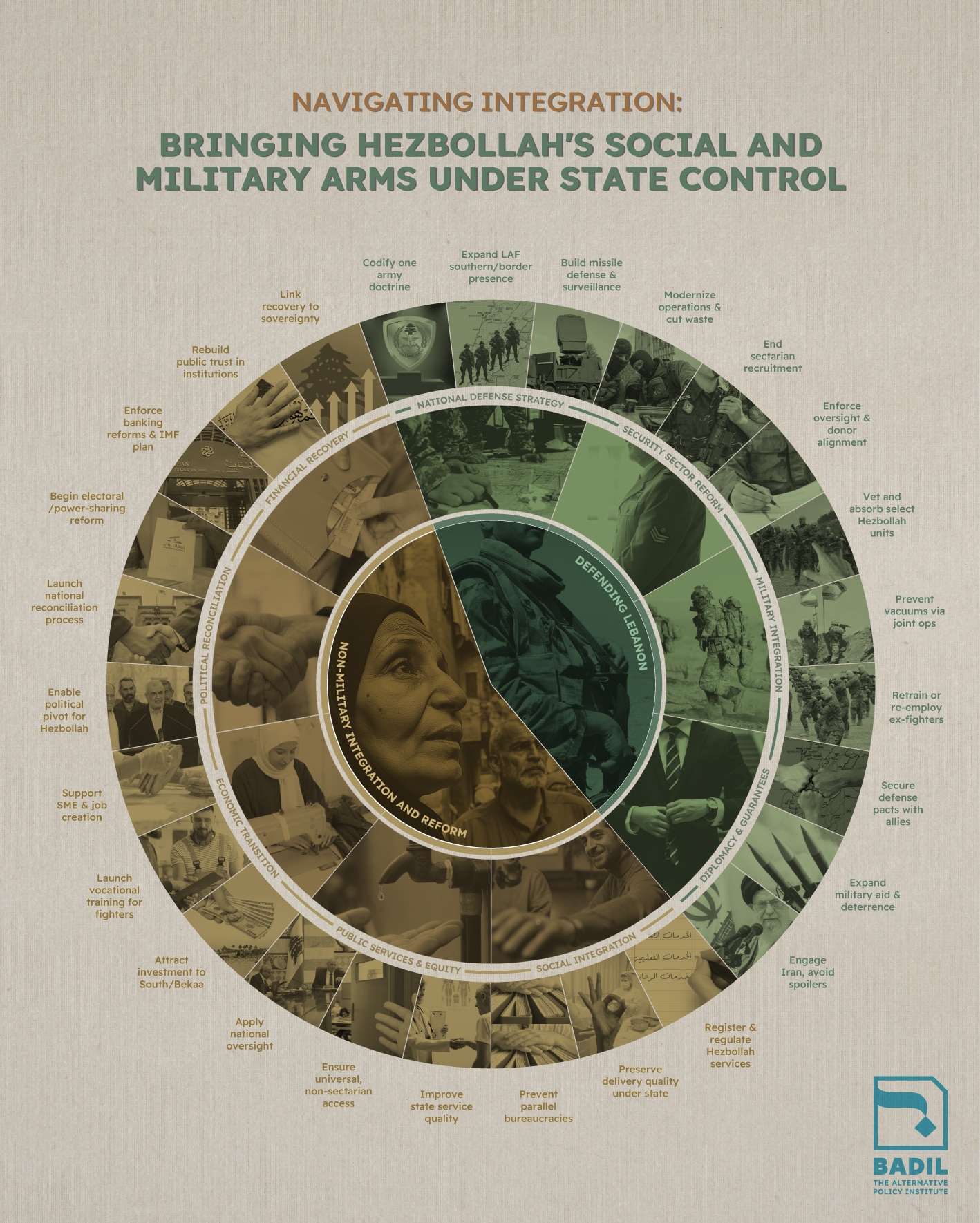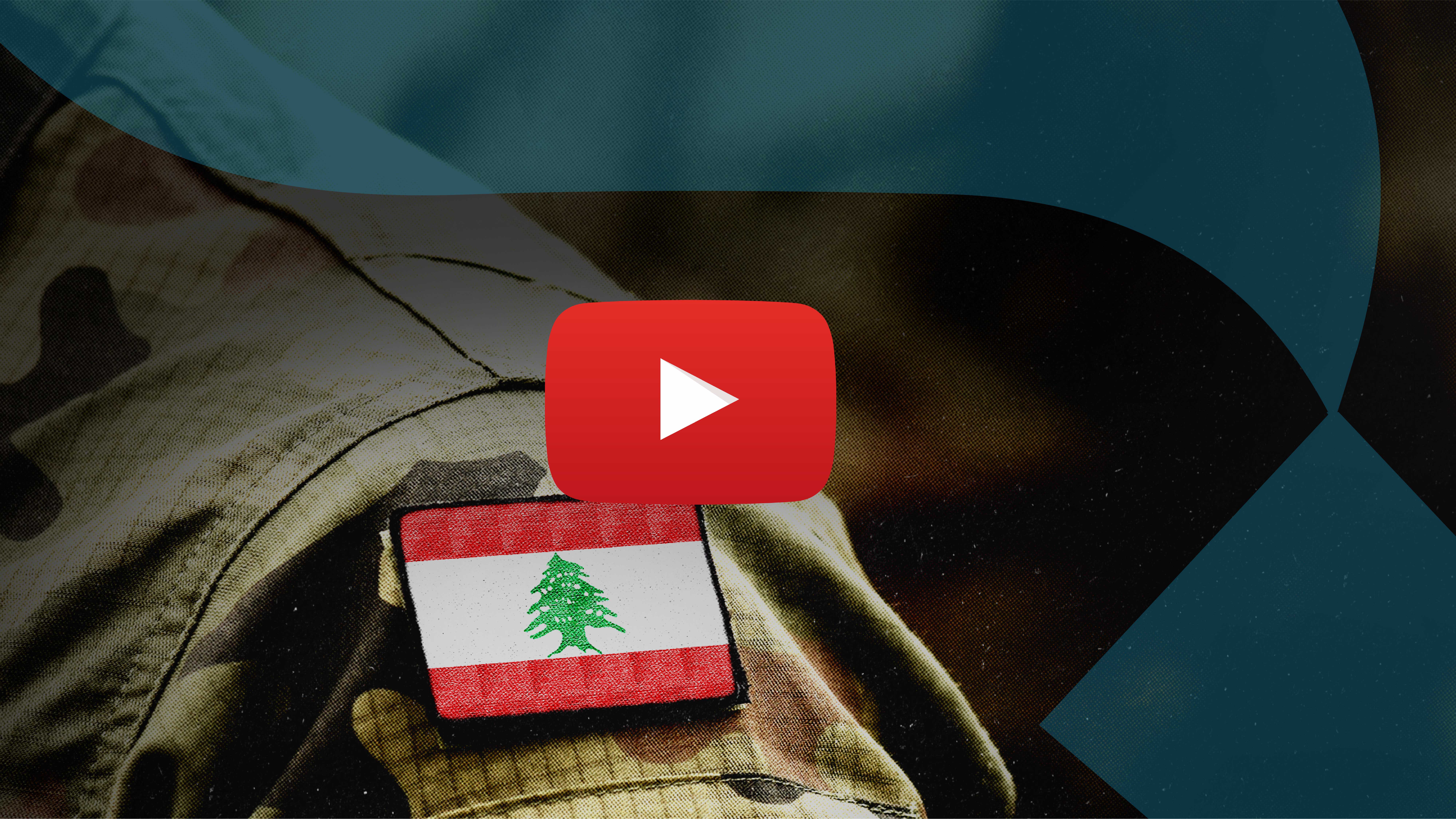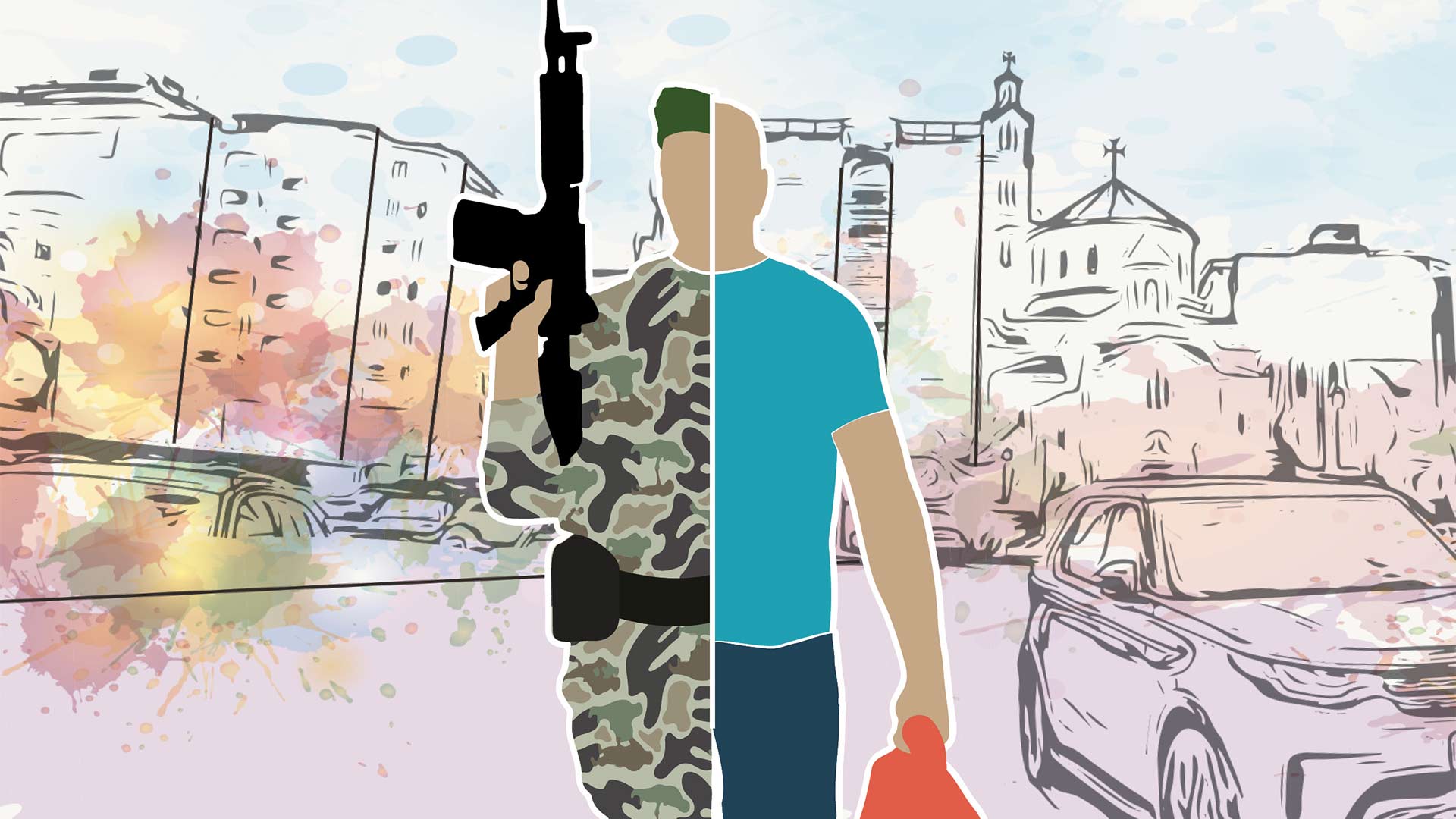Pillar I: Defending Lebanon
A New National Defense Strategy
Structural constraints that have historically undermined Lebanon’s ability to assert a unified security framework. The LAF, despite its status as Lebanon’s national military institution, remains hobbled by chronic underfunding, operational fatigue, a lack of advanced capabilities to address emerging threats, and a weak mandate. Reliant on international funding – primarily the United States, France, and Gulf states – the LAF faces both financial and political limitations. In its current state, the Lebanese army is ill-equipped to absorb Hezbollah personnel and equipment, or present a credible alternative to the group’s military deterrent.
A cornerstone of Hezbollah’s military transition is the development of a cohesive and robust National Defense Strategy that clearly defines the LAF’s role as Lebanon’s primary security guarantor. This requires a strategic national security realignment from Hezbollah’s asymmetric deterrence model toward a state-led defense posture, so as to garner the interest of diplomatic actors to secure sustainable military assistance. Key steps include:
- Codify Lebanon’s Security Doctrine: The government must articulate a formal security doctrine establishing the LAF as the sole military force responsible for national defense, integrating defensive postures that previously fell under Hezbollah’s control.
- Upgrade Lebanon’s Air & Missile Defense Capabilities: The LAF must be equipped with advanced air defense systems, surveillance infrastructure, and precision deterrence capabilities to deter Israeli threats. This includes securing defense partnerships with Western and regional allies or other emerging actors. This element is critical to provide Lebanon with the deterrence force in the south of Lebanon.
- Strengthen LAF Presence Along the Borders: Expansive LAF deployment south of the Litani River is critical to ensuring that security responsibilities once held by Hezbollah are fully absorbed into state institutions. Intelligence-sharing mechanisms with UNIFIL and other international stakeholders (such as the ceasefire monitoring mechanism co-chaired by the United States and France) should support this effort. Enhanced LAF border enforcement should also extend along the eastern and northern frontier with Syria.
LAF and Security Services Reform as a Prerequisite for Integration
Before integrating Hezbollah personnel, the LAF and other state security services must undergo deep structural reforms to enhance efficiency, strengthen their chains of command, and eliminate vulnerabilities that could be exploited during the transition. These foundational reforms will help prepare these state institutions to absorb Hezbollah personnel without compromising state sovereignty and legitimacy. In particular, they should ensure that integration does not result in Hezbollah maintaining a parallel influence network within the army and security services. These reforms include:
- Reform and Modernize: The LAF and other security services must embark on an ambitious internal reform focused explicitly on operational effectiveness, technological advancement, and financial sustainability. This involves rebalancing its unsustainable expenditure structure—currently dominated by personnel costs—by rationalizing troop numbers, recalibrating retirement and benefit systems, and reallocating resources towards modernizing equipment and infrastructure. Transparent financial management, strengthened civilian oversight, and a strategic shift towards operational capabilities adapted to contemporary security threats are essential. Crucially, these internal transformations must align with international donors’ strategic interests to secure sustained funding streams, thus creating a capable, modern, and fiscally sustainable national military that can credibly assume security responsibilities previously monopolized by Hezbollah.
- Command and Control Reinforcement and Capacity Building: The LAF and other security agencies must strengthen centralized military doctrine to prevent factionalism and ensure strict chain of command discipline. Reinforced command and control capacities will also help support professionalism throughout the ranks.
- Optimizing Security Sector Expenditures: All Lebanese security services must urgently adopt transparent, accountable, and strategically aligned frameworks for managing finances and human resources. At present, personnel costs dominate budgets largely due to the entrenched practice of sectarian-based recruitment. Security institutions must cease to function as channels for sectarian patronage or public employment schemes and instead prioritize operational effectiveness in national defense and internal security. While immediate reform will inevitably clash with constitutional safeguards for grade-one public sector positions and deeply rooted historical practices, there remains considerable room for reform beyond these limitations. A transitional strategy should thus focus on gradually phasing out older personnel recruited through sectarian quotas, replacing them incrementally with younger, merit-based recruits. Over time, this shift will significantly enhance operational efficiency, reduce waste, and recalibrate Lebanon’s security apparatus towards its core mission: safeguarding national sovereignty and internal stability.
Parallel Military and Security Integration
Hezbollah’s military integration under the LAF should happen in parallel with, and be supported by, general security sector reform within Lebanon, with Hezbollah’s local security networks also being integrated into national institutions. As national institutions take on increasing prominence over local law enforcement and national defense, this process will continue to center the state as the guarantor of order and social stability in Lebanon, helping to reinforce the broader national reconciliation process. Tenets of the integration process should be:
- Cooperation to Prevent Security Vacuums and the Proliferation of Nonstate Armed Groups: Both military and security integration should involve cooperation between state institutions and their Hezbollah counterparts to prevent power vacuums during the transitional process. From a security standpoint, joint patrols and operations should facilitate this process in the near term. In terms of the military transition, Hezbollah-LAF information-sharing mechanisms, such as joint operations rooms, should oversee and facilitate each phase of the integration process to ensure continued alignment with the overall NDS. Stakeholders must remain vigilant that Hezbollah’s transition does not result in the emergence of alternative security structures or new nonstate armed groups that seek to replace Hezbollah’s role.
- Selective Integration of Personnel: Absorbing Hezbollah personnel into state military and security apparatuses should be selective rather than wholesale to mitigate the risk of factionalism within state institutions. The vetting process must parse between ideologically committed veterans whose entrenched loyalties are likely to remain with Hezbollah, and newer, more transactional recruits with higher prospects of successfully integrating with state structures, given the right incentives. Selection of Hezbollah personnel for integration in state military-security apparatuses should also be merit-based to foster high-functioning institutional capacity and limit bloat. Retraining for these recruits should involve ideological and national loyalty conditioning. Consideration must also be taken regarding their disbursement throughout the LAF ranks to mitigate sectarian imbalances in any given unit.
- Weapons Collection and Oversight: A phased, monitored handover process must be implemented to track Hezbollah’s arms stockpiles, ensuring compliance with htor reforms. This should include the registration and storage of unauthorized weapons, followed by either their disposal or integration into the LAF, depending on which complies with security sector reform aims and the national NDS.
- Employment Support for Personnel Not Selected for Integration: When appropriate, Hezbollah personnel not selected for military integration should be transitioned into the civilian public service or offered severance and assisted in securing private sector employment (see below Pillar II). Social stability would be at risk if state programs did not provide alternative economic and social pathways for newly unemployed Hezbollah members who had built livelihoods within the group’s ecosystem.
Diplomacy and International Security Guarantees
Meaningful international security guarantees against Israeli incursions will be crucial support for the NDS’s success and the LAF’s ability to replace Hezbollah as the protector of Lebanese sovereignty in the country’s south. Without these credible international assurances integrated into Lebanon’s defense framework, it will remain politically untenable among Hezbollah’s support base for the organization to relinquish its military role. Thus, in addition to internal reforms, Lebanon must negotiate binding international security guarantees to safeguard its territorial integrity. These guarantees should replace Hezbollah’s justification for maintaining an armed wing while providing Lebanon with credible military and economic backing. Steps include:
- Securing Bilateral and Multilateral Defense Agreements: Lebanon must engage with key security and economic partners – including France, the US, Arab states, or others – to formalize mutual aid pacts that provide military and non-military mechanisms to deter Israeli violations of Lebanese sovereignty.
- Establishing Diplomatic Framework: Mechanisms to fast-track diplomatic interventions in the event of renewed conflict with Israel should be established, creating a further deterrent to the use of force.
- Expanding Military Aid Programs: Stakeholders with vested interests in regional stability should expand military aid and defense procurement agreements with the LAF, allowing it to professionalize and modernize its operational capacities.
- Balancing Regional Pressures: Given Iran’s strategic ties to Hezbollah, any transition must avoid triggering regional destabilization. This requires a diplomatic approach that seeks the support of regional actors that sign onto a ‘one nation, one army’ security framework for Lebanon. Should regional actors reject this framework, high-level diplomatic engagement must be maintained to mitigate spoiler effects.
Pillar II: Non-Military Integration and Reform
Hezbollah’s military, political and socioeconomic branches are integrated into an overarching resistance narrative, culture, and organizational structure. Fundamental changes to group’s military positioning, such as incorporation into the LAF, is thus unlikely to garner the necessary buy-in to succeed without addressing the wider ecosystem through which Hezbollah has integrated itself with its constituency. Any transition process must be approached as a phased, multi-year structure with parallel military and non-military tracks. The non-military transition must also result in the Lebanese state becoming the primary provider of basic services and socioeconomic protections for the country’s Shia community, while the country’s Parliament and judicial systems become places where the community feels it has access to political and legal recourse.
In the absence of effective state services and accountability mechanisms, Hezbollah’s extensive social and economic infrastructure has provided essential services to marginalized Lebanese communities for decades. The transition process’ goal should not be to dismantle Hezbollah’s social role but to integrate its effective service delivery mechanisms into a reformed Lebanese state, ensuring that these institutions function under national governance rather than operating in parallel to it. This process must balance state regulation, economic stabilization, and international buy-in, allowing for a transition where Hezbollah’s socioeconomic functions contribute to state-building rather than remaining outside of it.
Leveraging Capacity: Retaining Hezbollah’s Social Services Effectiveness
Hezbollah has demonstrated its ability to provide efficient and large-scale social assistance where the Lebanese state has failed. Its networks in healthcare, education, reconstruction, and financial assistance have filled critical gaps for populations that have historically been neglected. Rather than losing this expertise, Lebanon must find a way to incorporate Hezbollah-linked institutions into the national system, ensuring they are regulated and accountable but remain operationally intact. Key steps include:
- Formalizing Hezbollah’s Social Institutions: Hezbollah’s affiliated organizations providing health, education, and welfare services should be registered as NGOs or public service providers, ensuring compliance with national laws and oversight mechanisms.
- Integrating Financial Services Under State Regulation: Institutions like Al-Qard Al-Hassan, which function as de facto banks, must be brought under the supervision of Banque du Liban (BDL) and operate within national financial regulations, ensuring transparency and systemic stability.
- Reorienting Assistance Programs Toward State-Sponsored Initiatives: Hezbollah’s social aid programs should transition into state-supported social safety nets, ensuring that assistance is not politically or sectarian-driven but accessible to all Lebanese citizens.
Safeguarding the Integration of Public Services and Social Protections
There should be a phased approach to incorporating Hezbollah’s parallel civilian and social services infrastructure under state supervision. The first step requires state institutions to progressively improve their essential services delivery, accountability, and monitoring to be comparable to those Hezbollah has long provided. Under integration, Hezbollah’s civilian operations remain intact to avoid economic and social destabilization. However, as state institutions are strengthened, Hezbollah’s parallel structures will be brought under a system of national regulation, ensuring baseline standards and consistency country-wide, and thereby fostering national cohesion. To safeguard the integration process, particular care must be taken with the following:
- Preventing Parallel Bureaucracies: Hezbollah’s institutions must transition within the Lebanese legal framework, preventing the emergence of semi-autonomous service networks that bypass state authority.
- Avoiding Sectarian Domains within Public Service Delivery: The transition must ensure that state resources and services remain universally accessible to all Lebanese, rather than reinforcing exclusive or sectarian economic enclaves.
Economic Diversification & Private Sector Development
Hezbollah military-security personnel not incorporated into the LAF or other state security structures require viable economic and livelihood alternatives in the civilian realm. A key component of ensuring a smooth reintegration process is community development and local investment in economic opportunities that absorb this workforce and create long-term stability. Key priorities include:
- Encouraging Gulf and Western Investment in Infrastructure: Foreign investment in labor-intensive fields – such as reconstruction and infrastructure projects and energy sector development – can provide employment at scale for those shifting away from Hezbollah’s security structures.
- Bolster Domestic SME Investment Environment: Government policies should incentivize Lebanese to reshore capital and invest in small- and medium-sized enterprise development. This should include tax incentives and support for new entrepreneurs. Particular effort should be made to spur economic activity in historically underserved regions.
- Developing Vocational Training Programs: Targeted training programs should be established to retool and upskill individuals transitioning from military or security roles into the civilian workforce. These programs should be tailored so that the labor market expertise they create matches prevailing human resources demands.
Political Normalization under National Reconciliation
Hezbollah’s military transition requires that the organization have a plausible pivot into being a primarily political entity. The transition must thus be structured under the national reconciliation process to ensure that Hezbollah, and the Shia constituency more broadly, retains appropriate political representation within Lebanon’s democratic framework as the party relinquishes its military role. Necessary steps to achieve this include:
- Aligning Hezbollah’s Political and Security Transition: Given Hezbollah’s established political presence, the transition must ensure that elements of its military wing relevant to the national security framework are absorbed into state institutions under Pillar 1, while its political apparatus continues to operate within Lebanon’s democratic system. This process should be structured to reaffirm Hezbollah’s role as a political actor while preventing any informal security structures from emerging outside state control.
- Preventing Political Marginalization: Efforts must be taken to ensure Hezbollah’s military transition is not construed or arranged as an effort that will weaken Shia political representation. It must be clothed in language emphasizing loyalties to the state and national reconciliation, and as a realignment of the national security architecture that benefits all Lebanese citizens. Should the public imagination be captured by the idea that the military transition is a zero-sum political maneuver by Hezbollah opponents, political deadlock and a transition freeze would likely ensue.
- Pursue Economic Development to Supplant the Political Clout of Arms: Hezbollah’s arms have long provided the clout by which the Shia community, and in particular marginalized areas in South Lebanon and the Bekaa Valley, have secured a voice in government policy making. While the implicit political veto Hezbollah’s arms created must end, meaningful economic development and investment in marginalized areas should be pursued to offset the sense of disenfranchisement communities will feel about the party relinquishing its arms to state control. Without this supplanting effect, resistance to the military transition may be widespread.
- Reforming Sectarian Political Representation: There must be electoral and governance reforms ensuring that none of Lebanon’s sectarian communities feel alienated from the political process or unfairly represented within Lebanon’s power-sharing system. This will be a long, arduous process within the umbrella of national reconciliation, and Hezbollah’s military transition cannot be contingent upon these reforms being finalized and implemented. Meaningful progress in this area, however, will lend immense credibility to the military transition process, and thus such be pursued with urgency by domestic leaders and receive international backing.
- International Guarantees to Ensure Domestic Credibility for Military Transition: Concrete, enforceable international guarantees buttressing the LAF’s ability to deter Israeli aggression are required to bestow credibility upon the domestic political process associated with Hezbollah’s military transition. These guarantees must be binding and long-term, ensuring sustainability beyond immediate political cycles.
Resolving Lebanon’s Financial Crisis: A Parallel Imperative
Any credible strategy for integrating Hezbollah’s military and social institutions under state control must confront another profound crisis that afflicts Lebanon – the financial and banking sector collapse, which was driven by entrenched political sectarianism and its crossover with vested financial interests. Indeed, Hezbollah’s weapons are only one part of Lebanon’s dual crises: military dualism on one side, and on the other, an economic dualism wherein the interests of a narrow banking and political elite have overridden public welfare, effectively stripping the state of both legitimacy and financial viability.
Addressing this financial catastrophe is not an auxiliary measure but a crucial strategic pillar. Just as meaningful progress on Hezbollah’s integration requires a recalibration of political interests and alliances, so too does resolving the banking-driven financial meltdown, which demands confronting entrenched oligarchies that benefit from the status quo. Implementing an IMF-backed financial stabilization program, enforcing genuine regulatory oversight, and carrying out structural reforms – such as banking sector restructuring, transparent fiscal management, and reform of state-owned enterprises – are thus not merely economic actions but profoundly political steps.




